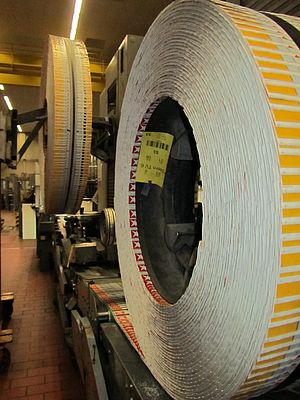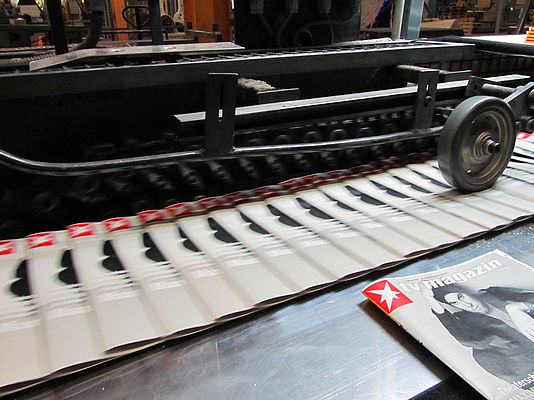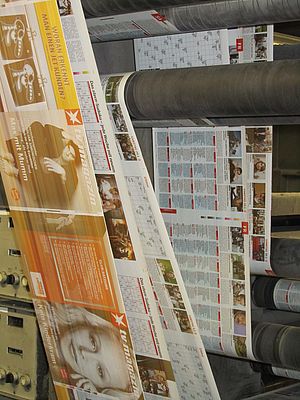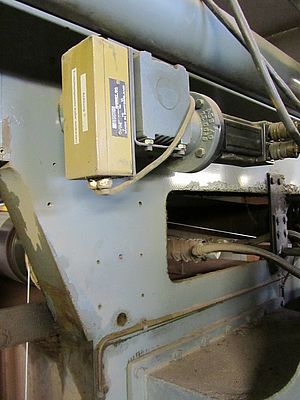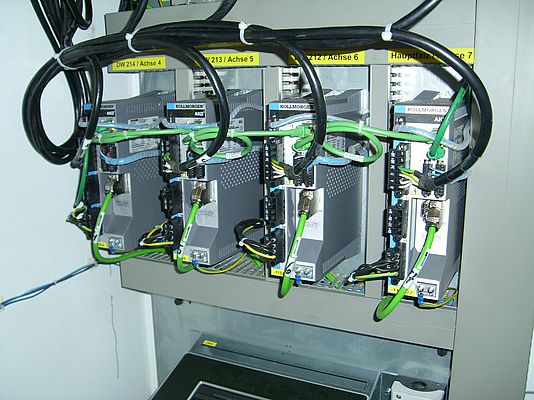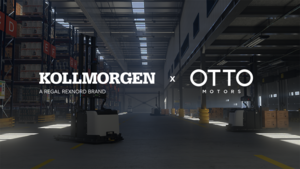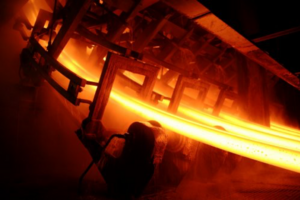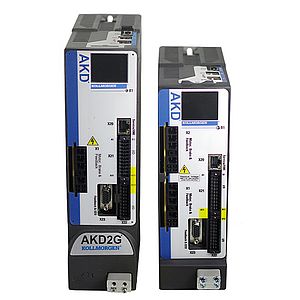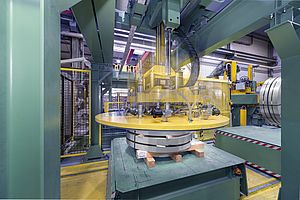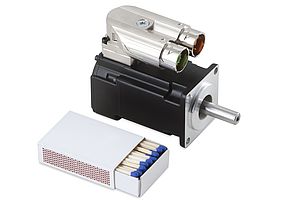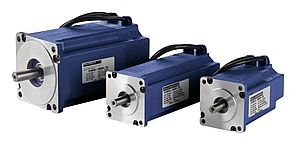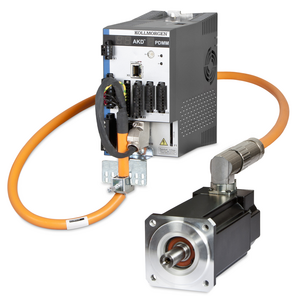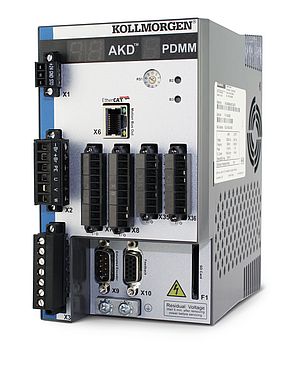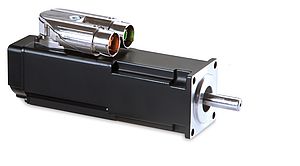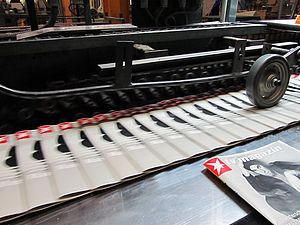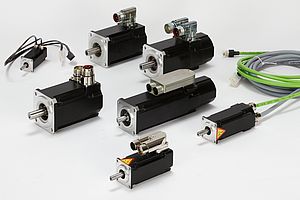In search of new controllers for register control of a rotogravure printing press, Prinovis Itzehoe GmbH implemented a new motion control solution from Kollmorgen that produced important, measurable results. By partnering with Kollmorgen, Prinvois was able to reduce scrap by at least 11 percent while increasing throughput by at least 13 percent when compared with their previous horizontal register control solution.
With sites in Ahrensburg, Dresden, Itzehoe, Liverpool and Nuremberg, Prinovis group is the leading gravure printing company in Europe, specializing in custom-made print-related communication solutions. Prinovis' core expertise is gravure printing, with a total annual capacity of 1.2 million tons. High-quality periodicals such as Spiegel, Stern, Brigitte and Geo are printed at the Itzehoe site, as well as other print products. The printing speed and quality requirements are correspondingly high, as from receiving the data to delivering the finished printed product, in some cases the printing process is only a half or three-quarter day.
Work at the Itzehoe site revolves around several gravure printing presses equipped with eight printing mechanisms. The majority of printed products run through these presses. In order to guarantee the highest possible register accuracy - the tolerance limit is 0.02 millimeters - the printing process is monitored using color-to-color registration and optical sensors. In the event of deviations caused, for example, by moisture warping the paper or by the minutest unevenness in the mills and rolls, the register rollers are activated. Register rollers stretch or release the rolls of paper in response to fractional upward and downward movement, thereby correcting the print layout horizontally.
The register rollers are controlled by a system consisting of an industrial PC, servo amplifiers and servomotors. When the old servo amplifiers failed in one press and replacement parts were not available, the management at Prinovis Itzehoe decided to modernize the register control in general, focusing in particular on guaranteeing the future availability of replacement parts. After a brief, intense search and initial discussions, drive and automation specialist Kollmorgen was chosen.
"Key to the decision was the fact that Kollmorgen does not just have products that will simply replace the old components, but provides a solution package with components that complement each other brilliantly, making the printing press even more efficient. It was also important for us that the old motors could still be operated with the new controllers so that they would not have been replaced in a single step, but gradually. With other providers, that is typically just not possible," says Jörg Ralfs, Support Electrical Engineering, Rotogravure Printing, at Prinovis.
Kollmorgen also scored points thanks to the simplicity of implementation. Prinovis only had to modify the switching cabinet for the new components - no other structural changes were needed. The high degree of user-friendliness, the ease of servicing and the price/performance ratio were also significant criteria in Prinovis' decision to work with Kollmorgen.
The Kollmorgen solution package for the press consists of eight highly dynamic, flexible AKD servo drives and eight high-performance, compact AKM servomotors. The package also came with an industrial PC and Kollmorgen Automation Suite automation solution - a software package with a drag‐and-drop-programming environment for the various machine/press functions that excels in terms of simple programmability and operation. An RS422 bus converter completes the package. The customized product set easily handles the up to 40,000 positioning commands per hour typical of the register control.
The controllers and the industrial PC were replaced in less than a day thanks to extensive prior planning. The new switching cabinet, for example, was built and tested before installation and Kollmorgen Automation Suite was set up on the industrial PC and tailored to the specific application in advance. Even before refitting, test and optimization runs were also carried out for all eight servo amplifiers - something that was only possible thanks to the simple and fast programming and the full virtual simulation provided by the Kollmorgen Automation Suite. Remarkably, the Kollmorgen team also updated the terms used on the industrial PC with standard printing industry terminology. "Ultimately, the person in charge of printing has to be able to control the machine safely," says Jörg Ralfs.
Besides the industrial PC and the controllers, one of the old motors was replaced by an AKM servomotor on the switchover day so that the motor parameters could be recorded during operation and saved on the AKD servo drive. This simplifies the gradual introduction of the remaining AKM servomotors. The uniquely extensive diversity of the series and the exceptionally comprehensive number of equipment options produced tangible results during the switch over to the AKM servomotor.
"We did not just deliver a servomotor that performs better than the old motors - we delivered a motor that had the exact physical properties for the application. So Prinovis did not have to make any elaborate adjustments to the mechanics. We were also able to save time and money by connecting the AKM servomotor to the existing control cable with short cable adapter parts. If that had not been possible, we would have had to lay a new cable meters long," says Udo Wildenblanck, Key Account Manager, Industrial Automation, at Kollmorgen Europe. Kollmorgen had also tailor-made the motor for Prinovis ex factory, which simplified the on-site installation.
Once refitting was completed, an independent company audited the installation and the results were impressive. Using Kollmorgen Automation Suite and the AKD servo amplifiers, scrap caused from changing rolls was reduced by at least 11%. That translates into an increase in throughput of at least 13%, even when running down and starting up the press during the printing process.
"The controllers we have now are more dynamic and the frames are processed faster than in the old system. With the old system, only roughly every third or fourth control step could be completed at very high press speed. Now, every deviation can be recorded and corrected immediately. That means the register accuracy is achieved considerably more quickly, which means high-quality material can be produced more rapidly, and less spoilage is generated. Quality and throughput increase," Explains Wildenblank. "Additionally, as every control cycle can be recorded, the corrections do not have to be as extreme. That is good for the roll mechanics."
"The old system used to handle the tolerances as does the new system, but the old system was generally more error-prone. Hence, we now have fewer interruptions and associated costs. We were also attracted by the high degree of flexibility of the solutions, the excellent technical advice and the very high customer focus of Kollmorgen. The system has been designed transparently, so that any service technician can manage it - which is very important," says Ralfs.
A second press has since been refitted and refitting is currently at the planning stage for two more presses. Based on the success of the initial application, Prinovis has additional new projects in the pipeline with Kollmorgen.


